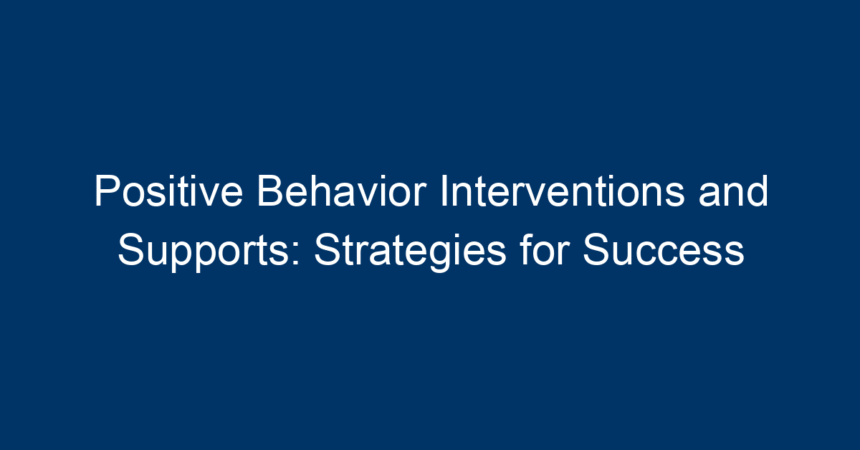In today’s educational landscape, fostering positive behavior in students is more critical than ever. With increasing challenges in classroom management, educators are turning to innovative approaches. One such framework gaining traction is Positive Behavior Interventions and Supports (PBIS). This research-backed model focuses on promoting positive behavior as a means to create safer and more effective learning environments. In this article, we will explore the fundamentals of PBIS, effective strategies for implementation, and actionable insights for educators aiming to make a difference in their classrooms.
Understanding Positive Behavior Interventions and Supports
What is PBIS?
Positive Behavior Interventions and Supports is a proactive approach designed to enhance the school environment by explicitly teaching and rewarding appropriate behaviors. Rather than merely reacting to negative behaviors, PBIS emphasizes prevention and intervention through a structured framework that supports both students and educators.
The Core Principles of PBIS
PBIS is grounded in a few key principles:
- Positive Reinforcement: Rewarding students for demonstrating expected behaviors helps to increase occurrences of those behaviors.
- Data-Driven Decision Making: PBIS heavily relies on data collection and analysis to understand student behavior and inform interventions.
- Universal Strategies: Base interventions apply to all students, creating a consistent approach in diverse educational settings.
- Individualized Support: While the framework starts with universal supports, it recognizes that some students may need additional, tailored interventions.
The Benefits of Implementing PBIS
Creating a Positive School Culture
Implementing Positive Behavior Interventions and Supports leads to a more positive school culture. Schools that adopt PBIS report an increase in student engagement, a reduction in disciplinary actions, and a stronger sense of community.
Reduced Behavior Problems
Research indicates that schools utilizing PBIS observe a significant decrease in disruptive behaviors. By focusing on prevention and intervention, students learn appropriate social skills and return to academics more quickly after behavioral incidents.
Improved Academic Performance
When students feel safe and supported, they are more likely to engage in their studies. The positive atmosphere promoted through PBIS contributes to enhanced academic performance as students are empowered to focus on learning rather than managing behavioral issues.
Key Strategies for Successful Implementation of PBIS
1. Establish Clear Expectations
To create a successful PBIS framework, it’s essential first to establish clear, concise behavior expectations. Schools should collaboratively develop a set of core values, such as respect, responsibility, and kindness, that apply in all areas of the school environment—classrooms, hallways, cafeterias, and playgrounds.
2. Teach and Model Expected Behaviors
Once behavior expectations are established, it’s crucial to teach these behaviors explicitly. This can be done through direct instruction, modeling by teachers, role-playing, and incorporating these lessons into everyday activities. For instance, educators could create short lessons on how to engage respectfully with peers, emphasizing the why behind each expected behavior.
3. Utilize Tiered Supports
PBIS operates on a tiered system, ensuring that all students receive appropriate supports based on their needs.
- Tier 1: Universal supports for all students.
- Tier 2: Targeted interventions for students who need additional support.
- Tier 3: Intensive, individualized interventions for students exhibiting severe or chronic behaviors.
This tiered approach allows for flexibility and responsiveness to diverse student needs.
4. Implement a Reward System
Incorporate a robust reward system to recognize and reinforce positive behaviors. This could include token economies, where students earn tokens for displaying expected behaviors, or a point system that leads to privileges or prizes. Celebrating achievements—both big and small—encourages sustained positive behavior over time.
5. Collect and Analyze Data
Effective implementation of PBIS relies on data collection to monitor student behavior and the effectiveness of interventions. Schools should use data to track behavioral trends, identify areas of concern, and refine strategies as needed. Regularly assess what is working and what needs adjustment.
6. Foster Family and Community Involvement
Engaging families and the community is vital for the success of PBIS initiatives. Schools can host workshops to inform parents about the system and encourage them to reinforce positive behaviors at home. Furthermore, creating partnerships with local organizations can provide additional resources and support for students.
Common Challenges in PBIS Implementation
Resistance to Change
Implementing PBIS may encounter resistance from staff, students, or parents accustomed to traditional disciplinary methods. To overcome this, it is vital to communicate the benefits of PBIS clearly and involve stakeholders in the decision-making process.
Inconsistency in Application
Inconsistencies in applying PBIS practices can undermine the framework’s effectiveness. Regular professional development and training for educators are essential to ensure a shared understanding of PBIS principles and practices across the school.
Insufficient Resources
Many schools may struggle with limited resources to fully implement PBIS. Seeking grants, community partnerships, or alternative funding sources can provide the necessary support to sustain and enhance PBIS efforts.
Actionable Insights for Educators
- Start Small: Begin with one or two classroom strategies aligned with PBIS principles and expand as you gain experience and confidence.
- Collaborate with Colleagues: Work with other educators to share insights, strategies, and resources, ensuring a collective approach to PBIS implementation in the school.
- Involve Students: Encourage student input when establishing behavior expectations or reward systems. Students who feel a sense of ownership are more likely to adhere to established norms.
- Regular Reflection: Continuously evaluate the impact of PBIS practices in your classroom and be open to making adjustments based on student needs and behaviors.
- Celebrate Successes: Recognize and celebrate the achievements of students, staff, and the school community in adopting and embracing PBIS principles. This fosters motivation and reinforces positive behavior.
Conclusion
Positive Behavior Interventions and Supports is more than just a framework—it’s a comprehensive approach to transforming the educational landscape. By emphasizing proactive strategies, schools not only enhance the overall climate for learning but also equip students with crucial social and emotional skills they will carry beyond the classroom. As educators adopt PBIS, they contribute to a culture of respect, responsibility, and community, setting the stage for lifelong success for their students.
Incorporating the strategies outlined above will help ensure that the benefits of PBIS are fully realized, paving the way for an engaging, supportive, and productive educational experience for all. With a commitment to continual improvement and collaboration, schools can harness the power of PBIS to drive lasting change.




